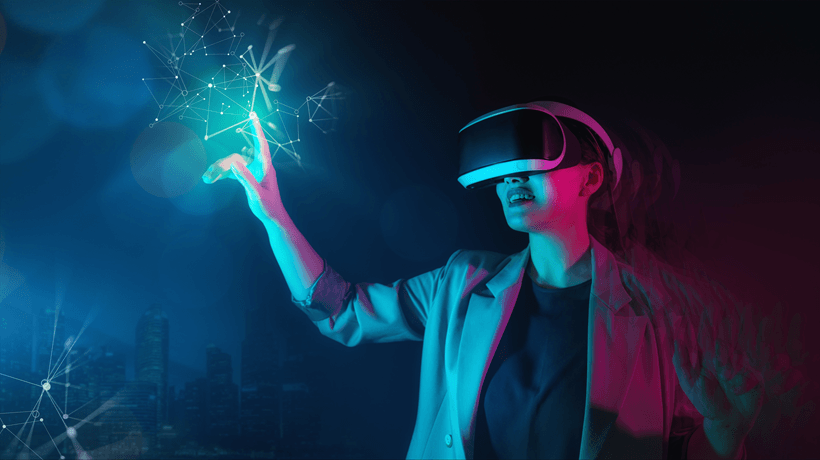How Is Technology Transforming Learning?
Traditional learning approaches struggle to meet the dynamic demands of the digital age. Yet, in today’s rapidly evolving business landscape, reskilling and upskilling have become imperative for individuals and organizations to stay competitive. As a result, the integration of interactive L&D technology in eLearning has transformed how businesses educate their learners. When it comes to modernizing workforce skills, technology has emerged as a powerful ally to facilitate rapid, effective reskilling and upskilling.
However, as businesses use interactive technologies to enhance eLearning experiences, it is also crucial to strike a balance by preserving the human aspect of learning. The human element contributes to the effectiveness of eLearning by fostering personal collaboration, “humanizing” communication, and injecting emotional intelligence into the L&D process. Technology also enhances human-to-human interactions through technology-driven coaching and mentorship. Transformation happens from technology’s ability to fully empower the human factor.
L&D Technology Trends That Future-Proof Learning
The relentless pace of technological advancements and industry disruptions has created a pressing need for businesses to reskill and upskill their workforce. Organizations must embrace emerging L&D technology to future-proof learning. Examples of trending and emerging learning technologies include the following.
Artificial Intelligence (AI) And Machine Learning (ML)
Benefits:
- Greater learner engagement.
- Increased visibility of learner performance gaps.
- Dynamic learner data analytics.
- Greater automation across learning ecosystems.
- Customized learning pathways.
How L&D can leverage this technology trend to create successful learning:
- Incorporating AI and ML via intelligent content curation helps create more personalized and engaging learning content and experiences.
- Adaptive assessments dynamically automate the level of difficulty for testing learners.
- The use of predictive analysis and learning data analytics helps identify learning and performance gaps. AI tools then highlight personalized learning pathways and provide individualized review, revision, and remediation recommendations.
When to use it:
Businesses should consider leveraging AI and ML to address large-scale training needs, provide personalized learning experiences, and support continuous learning efforts. These trending technologies can also help deliver complex or interactive content, aid with making data-driven L&D decisions, and automate administrative tasks. These L&D technology trends can enhance the effectiveness, efficiency, and scalability of learning initiatives, leading to improved employee reskilling/upskilling and performance.
Nano-Gamification
Benefits:
- The use of nano-gamification in upskilling and reskilling efforts can lead to increased learner engagement, heightened motivation to learn, active participatory learning, and rapid skills development.
- Through a data-centric approach, it creates a personalized, immersive, and enjoyable learning experience, albeit one that fosters competitiveness.
- The use of small-scale (micro/nano) gaming supports unique gaming elements targeted at specific aspects, processes, or tasks for continuous growth. This keeps the workforce aligned with evolving skills and competencies.
How L&D can leverage this technology trend:
L&D teams can leverage nano-gamification in various use cases to deliver focused, targeted, and impactful learning programs. Some examples of this L&D technology include:
- Onboarding and orientation.
- Compliance training.
- Product or service training.
- Skill development and reinforcement.
- Sales training and motivation.
- Instilling a culture of continuous learning and professional development.
When to use it:
L&D teams can apply nano-gamification in various contexts, particularly when the target subject matter is especially drab and boring. Leverage it to make learning programs more interactive, engaging, and effective. Incorporate game-like elements on a micro scale to increase learner motivation, promote knowledge retention, and deliver impactful learning experiences. Use nano-gamification when you want your workforce to “learn through play” learning interventions.
Virtual And Augmented Reality (VR/AR)
Benefits:
- Some of the numerous benefits of using L&D technology trends such as VR/AR come from the delivery of more immersive learning experiences.
- Another innovative way through which workforces benefit from this technology is the ability for learners to receive realistic, hands-on experiential learning.
- Learners also benefit from the fact that this technology provides them the opportunity to easily interact with AI-generated personalized and adaptable learning environments.
How L&D can leverage this technology trend:
- Businesses can leverage this L&D technology to create virtual simulations to practice real-world skills.
- It can help learners embark safely on virtual field trips, such as exploring deep inside a toxic mine or traveling through inhospitable climes.
- It can also be used to incorporate complex language and cultural nuances into learning content to help learners interact virtually with unfamiliar cultures and environments.
When to use it:
VR and AR are ideal technologies to deploy in circumstances where learning in a real-world setting might be cost-prohibitive. It can also be useful to leverage such technologies in risky learning situations—such as dealing with toxic chemicals or operating on high-risk patients. It also lends itself well to situations that require repetitive learning and practice.
Nano- And Microlearning
Benefits:
Today’s workplace is extremely busy, with hallmarks being multitasking and a workforce on the go. Nanolearning and microlearning offer benefits such as:
- Time efficiency, accessibility (on-the-go, anytime-anywhere learning), just-in-time learning, and continuous learning for the modern workforce.
- Learning is shorter and gets more streamlined for today’s busy employees.
- And because of its small footprint, businesses benefit from nano/microlearning L&D technology trends by creating focused, targeted training interventions.
How L&D can leverage this technology trend:
- By incorporating targeted nano- and microlearning, organizations can deliver impactful learning programs that align with the needs and preferences of their learners. This results in enhancing skills, knowledge retention, and overall performance.
- L&D can utilize these technologies to produce micro videos, infographics and visual summaries, flashcards, and knowledge checks/quizzes.
- Businesses may also integrate this L&D technology through interactive and gamified modules, mobile learning applications, social learning and collaboration, data-driven personalized learning paths, and customized performance-based assessments.
When to use it:
Because of their small footprint, these technologies are ideal for use to deliver learning through mobile devices. They serve as highly effective job aids and support tools. Short-form learning content, such as “how to” videos and interactive PDFs, is also great to use for in-the-moment-of-need and at-the-place-of-need training.
Video-Based Learning
Benefits:
- Shorter and more interactive videos are a trending technology in today’s L&D toolbox because they offer greater engagement and longer learning retention.
- Accessibility of such content, hosted on AI-powered corporate learning platforms, also allows for the targeted discovery of learning on social media sites and corporate learning platforms.
- Combining visual and auditory stimuli makes this technology great for catering to different learning preferences.
How L&D can leverage this technology trend:
Because of its dynamism, L&D can use it in myriad ways. These include:
- Microlearning videos.
- Interactive video-based content.
- Podcasts, webinars, and live streaming.
- Employee/user-generated content and social learning videos.
- You may also use these L&D technology trends by creating personalized video playlists as part of customized learning pathways.
When to use it:
It can be highly effective when there’s a need for multimodal learning. Videos are an ideal tool for use when there’s a need to demonstrate complex processes, procedures, or skills. This L&D technology may be used when the learning need is for showcasing real-life scenarios and providing practical examples. It is also ideal to facilitate the transfer of knowledge and skills directly applicable to the workplace.
In the coming years, the interactive eLearning technologies discussed here will continue to play a pivotal role in creating a continuous learning ecosystem. These L&D technology trends go beyond just facilitating reskilling/upskilling of the workforce; they also enhance the learning experience by providing engaging and immersive platforms that facilitate active participation, feedback, and real-time collaboration.
Business Benefits Of Leveraging Technology In Learning And Development
The rapid pace of advances in eLearning has made leveraging technology crucial for L&D. The use of trending learning technologies promises a wealth of benefits to businesses that embrace them. These include:
- Greater learning retention
Multimodal learning, through audio and visual content, and realistic virtual practice elements help increase learning retention. Technologies such as VR/AR and Mixed Reality also heighten learner engagement. This leads to increased on-the-job learning transference, which then increases the Return On Investment (ROI) through performance and productivity gains.
- Accessibility and scalability
Nano/microlearning technology solutions help reduce learning time and make learning ubiquitous by facilitating learning anywhere, anytime. Tech-driven learning solutions are now more easily scalable and accessible across the organization, delivering cost-effective, personalized learning across the workforce.
- Preserving the human factor
Tech-driven learning helps entrench the human factor by enabling person-to-person collaboration and knowledge sharing. Technology also facilitates human-to-human learning in the form of better coaching and mentoring encounters. And it preserves and enhances that human factor through person-to-person networking technologies, such as video-sharing platforms, social media portals, and learner-to-learner/peer learning groups.
Parting Thoughts
In the face of swiftly developing business requirements, interactive technology has become a vital tool in the eLearning toolbox to help reskill and upskill the workforce. It offers engagement, personalization, scalability, and practical application while also helping learning needs align with the needs of modern organizations. Most importantly, the L&D technology trends discussed here don’t supplant human-to-human contact; they help to enhance and empower the human factor in learning.
Read More:
- eBook: 2023 Learning Trends For The Connected Workplace
- Introduction to Immersive Learning
- AI in eLearning – How Natural Language Processing and Other AI-enabled Solutions Will Transform the Industry
- Immersive Training in Action – Featuring 6 Examples of Immersive Learning in the Workplace
- Why Invest on a Learning Technology Stack to Drive Employee Experience









